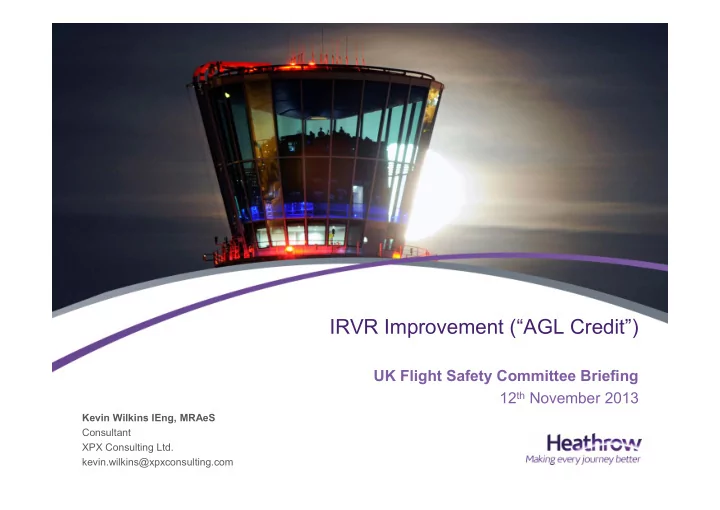

IRVR Improvement (“AGL Credit”) UK Flight Safety Committee Briefing 12 th November 2013 Kevin Wilkins IEng, MRAeS Consultant XPX Consulting Ltd. kevin.wilkins@xpxconsulting.com
Agenda • Introduction/Agenda • Current (Historical) IRVR Scenario • AGL Cleaning Trial - Summary & Summary Results • Proposed Operational Model for Winter 2013/14 • Resultant IRVR Scenario & Futures • Questions
Current (Historical) IRVR Scenario • Current calculations of Instrumented Runway Visual Range provide unduly pessimistic figures, this results in Low Visibility procedures being enacted more often than is operationally necessary (when IRVR <600m) 1 • This is due to an assumption that Runway Aeronautical Ground Lighting operates at no greater than 20% of design maximum luminescence. This assumed performance (used in automatic IRVR calculations) is far less than actual performance due to Heathrow’s superior AGL maintenance & cleaning regimes • Recent changes to CAP670 (with input from Heathrow) now allow for an assumed minimum AGL luminescence performance of 40% of design maximum, up to a maximum of 80%, if appropriate evidence is provided 1 - Study by TMS for HAL shows a potential reduction of 37 minutes per LVP day, equating to approx. 24 landings per LVP day (at an assumed luminescence of 75%)
AGL Luminescence Degradation Trial at LHR – Summary • Two week trial conducted in March 2013 • Plan was to deep clean all Runway AGL on day 0 of the trial and then conduct MALMS (Mobile Airfield Light Monitoring System) check runs every two nights with no cleaning or maintenance during the trial to monitor luminescence degradation over time • However, due to operational safety requirements (adverse weather & Anti/De- Icing operations) cleaning was unavoidable • Although disruptive to the trial, a reasonable amount of data had been collected • Anti/De-Icing impacts provided valuable learning
AGL Luminescence Degradation Trial – Summary Results Ave Beam Intensity (smoothed)
Required Cleaning Regime in Anti/De-Icing Conditions If Anti/De-Icing occurs ≥ 3 days before a scheduled 7 day AGL cleaning run an additional run must be performed within 2 days
AGL Luminescence Degradation Trial – Summary Findings • Degradation immediately following full deep-clean on day 0 appears to confirm ICAO & CAA assumption of a maximum performance of approx. 80% • Subsequent degradation appears largely linear (if impacts of adverse operations are ignored) • Average Peak Beam Intensity across all four runways for the duration of the trial (with cleaning interventions) measures approx. 65% – However, Average Peak Beam Intensity did not consistently exceed 52% for all four runway directions within a seven day cleaning cycle, however adverse conditions make this difficult to assess • Based on very limited data the average Degradation Rate across the trial was approx. - 5%/day (or -2.75%/day if smoothed) – Assuming a 100% situation at day 0, after day 6 AGL will have degraded to 84% Ave Peak Beam Intensity (best case) or 70% (worst case)
Proposed Extended Operational Trial for Winter 2013/14 • Pending imminent final approval from CAA SARG, Heathrow will run a further extended operational trial during Winter 2013/14 (Nov 2013 – April 2014) • NATS are producing a Safety Assessment assuming the use of an initial AGL de-rating factor of 60 % (i.e. 40% degradation from CAP168 maxima) for the trial, based on: – Weekly Cleaning of Runway Edge AGL – Monthly MALMS checks (with provided Average Peak Beam Intensity readings) – Monitoring of aircrew and controller feedback during trial via FLOPSC – Post Anti/De-Icing cleaning of AGL as soon as is practicable and within 2 days if no scheduled clean will occur for 3 or more days from Anti/De-Icing activity – Non-water based option if ambient temp. <4 0 C – Additional cleaning maintained in accordance with aerodrome SMS if required • Subsequent further improvements should be expected to be achievable based on the results of this further trial, cost/benefit analysis may be appropriate
Questions?
Recommend
More recommend